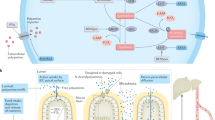Abstract
Tissue polyamine levels were determined in patients with colon adenocarcinoma to try to identify biochemical indicators able to characterize the growth and the metabolism of human solid tumors. Polyamine content was determined in the tumor and in the “healthy” mucosa sampled at different distances within the resection edges. For each patient the polyamine content in the tumor was compared with that in the mucosa. The results demonstrated that the spermidine concentration was higher in the tumor than in the healthy mucosa; the differences were statistically significant. However, spermine in the tumor increased to a lesser degree. No statistically significant differences were observed among these mucosae at different localizations, but the spermine concentration in the mucosa after the tumor showed values very close to those of the neoplasia.
Similar content being viewed by others
References
Tabor CW, Tabor H. Polyamines. Ann Rev Biochem 1984;53:749–90.
Seiler N, Bolkenius FN, Rennert OM. Interconversion, catabolism, and elimination of the polyamines. Med Biol 1981;59:334–46.
Pegg AE, McCann PP. Polyamine metabolism and function. Am J Physiol 1982;243:C212–21.
Marton LJ, Morris DR. Inhibition of polyamine metabolism: biological significance and basis for new therapies. In: McCann PP, Pegg AE, Sjoerdsma A, eds. Orlando: Academic Press, 1987:79–105.
Snyder RD. Polyamine depletion is associated with altered chromatine structure in HeLa cells. Biochem J 1989;260:697–704.
Pegg AE. Polyamine metabolism and its importance in neoplastic growth and as a target for chemotherapy. Cancer Res 1988;48:759–74.
Marton LJ. An approach to the use of polyamine inhibitors for cancer therapy. Med Biol 1981;59:458–61.
Talpaz M, Plager C, Quesada J, Benjamin R, Kantarjian H, Gutterman J. Difluoromethylornithine and leukocyte interferon: a phase I study in cancer patients. Eur J Cancer Clin Oncol 1986;22:685–9.
Maddox AM, Freireich EJ, Keating MJ, Haddox MK. Alterations in bone marrow and blood mononuclear cell polyamines and methylglyoxal bis(guanylhydrazone) levels: phase I evaluation ofα-difluoromethylornithine and methylglyoxal bis(guanylhydrazone) treatment of human hematological malignancies. Cancer Res 1988;48:1367–73.
Russell DH, Durie BG. Polyamines as biochemical markers of normal and malignant growth: progress in cancer research and therapy, vol. 8. New York: Raven Press, 1978.
Becciolini A, Porciani S, Lanini A, Balzi M. Polyamine content as marker of radiation injury in spleen. Int J Radiat Biol 1987;52:767–74.
Becciolini A, Porciani S, Lanini A, Attanasio M. Polyamines in the small intestine of rats after whole body irradiation. Int J Radiat Biol 1989;56:67–73.
Luk GD, Baylin SB. Polyamines and intestinal growth: increased polyamine biosynthesis after jejunectomy. Am J Physiol 1983;245:G656–60.
Luk GD, Marton L, Baylin SB. Ornithine decarboxylase is important in intestinal mucosal maturation and recovery from injury in rats. Science 1980;210:195–8.
Johnson LR, Tseng C, Wang P, Tipnis UR, Haddox MK. Mucosal ornithine decarboxylase in the small intestine: localization and stimulation. Am J Physiol 1989;256:G624–30.
Luk GD, Hamilton SR, Yang P, Smith JA, O'Cellaigh D. Kinetic changes in mucosal ornithine decarboxylase activity during azoxymethane-induced carcinogenesis in the rat. Cancer Res 1986;46:4449–52.
Gilmour SK, Verna AK, Madara T, O'Brien TG. Regulation of ornithine decarboxylase gene expression in mouse epidermis and epidermal tumors during two-stage carcinogenesis. Cancer Res 1987;47:1221–5.
Luk GD, Baylin SB. Ornithine decarboxylase as a biological marker in familial colonic polyposis. N Engl J Med 1984;311:80–3.
Rhozin J, Wilson PS, Bull AW, Nigro ND. Ornithine decarboxylase activity in the rat and human colon. Cancer Res 1984;44:3226–30.
Kingsnorth AN, Lumsden AB, Wallace HM. Polyamines in colorectal cancer. Br J Surg 1984;71:791–4.
Moorehead RJ, Hoper M, McKelvey ST. Assessment of ornithine decarboxylase activity in rectal mucosa as a marker for colorectal adenomas and carcinomas. Br J Surg 1987;74:364–5.
Porter CW, Herrera-Ornelas L, Pera P, Petrelli NF, Mittelman A. Polyamine biosynthetic activity in normal and neoplastic human colorectal tissues. Cancer 1987;60:1275–81.
Luk GD. Polyamines and colon cancer cells. Colon cancer cells. In: Moyer MP, Poste GH, eds. San Diego: Academic Press, 1990:279–88.
Bandettini L, Filipponi F, Balzi M, Scubla E, Becciolini A. Mitotic and labelling indices in human colorectal cancer (abstr). Int. Symp. Biological regulation of cell proliferation. Milan 1986:18.
Bandettini L, Balzi M, Scubla E, Becciolini A, Cardini A. Cell kinetics parameters in the mucosa of patients affected by colonic tumors. XXVI World Congr. Int. Coll. Surg. Milan, 1988:V407–10.
Deschner EE. Epithelial cell kinetics in colorectal mucosa of patients at high risk for colon cancer. Colon cancer genetics. In: Lynch PM, Lynch HT, eds. New York: Van Nostrand Reinhold Company Inc, 1985:111–27.
Bradford MM. A rapid sensitive method for the quantitation of microgram quantities of protein utilizing the principle of protein-dye binding. Anal Biochem 1976;72:248–54.
Author information
Authors and Affiliations
About this article
Cite this article
Becciolini, A., Porciani, S., Lanini, A. et al. Polyamine levels in healthy and tumor tissues of patients with colon adenocarcinoma. Dis Colon Rectum 34, 167–173 (1991). https://doi.org/10.1007/BF02049993
Issue Date:
DOI: https://doi.org/10.1007/BF02049993




